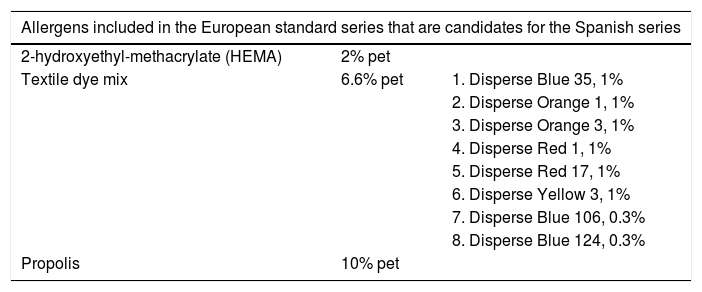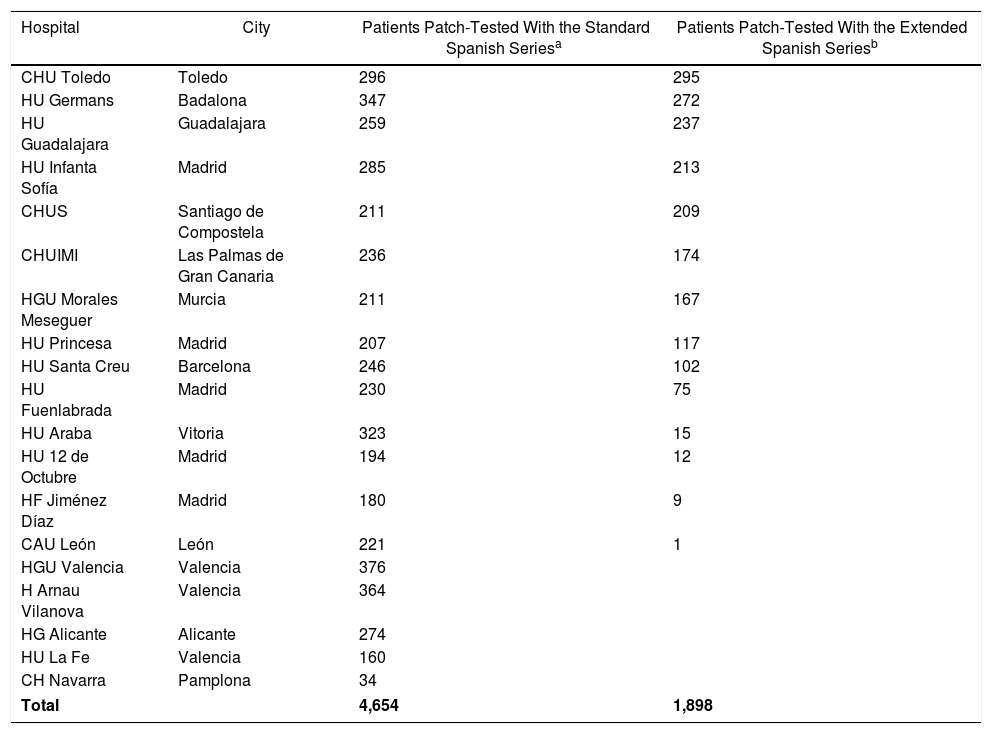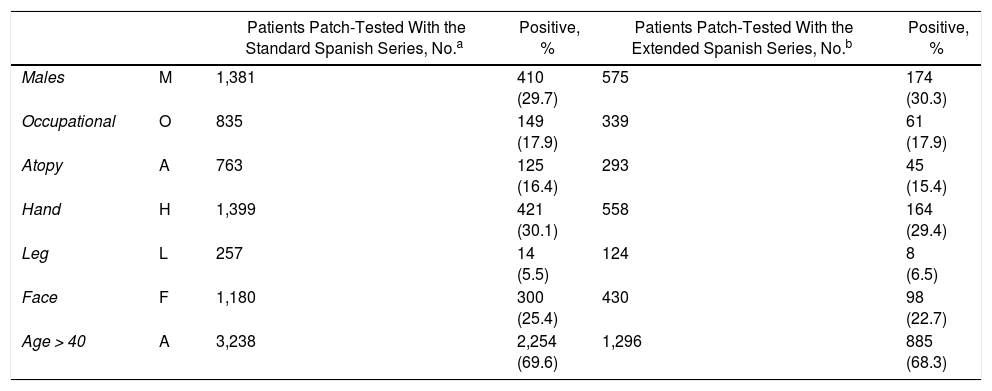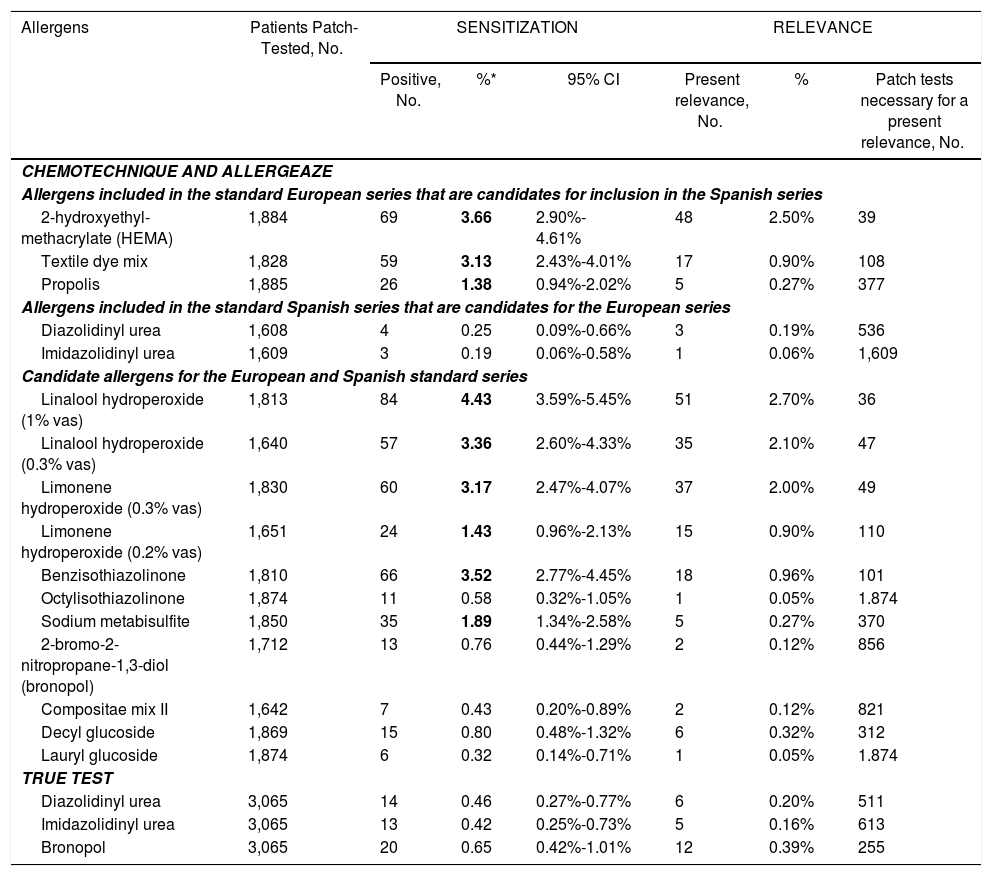Standard patch test series must be updated using objective data on allergen sensitization. The Spanish standard series was last updated in 2016 and the European series in 2019, and the inclusion of several emerging allergens needs to be evaluated.
Material and methodsWe conducted a prospective, observational, multicenter study of consecutive patients from the registry of the Spanish Contact Dermatitis and Skin Allergy Research Group (GEIDAC) who were patch tested in 2019 and 2020 with linalool hydroperoxide, limonene hydroperoxide, 2-hydroxyethyl-methacrylate, benzisothiazolinone, octylisothiazolinone, textile dye mix (TDM), sodium metabisulfite, propolis, bronopol, Compositae mix II, diazolidinyl urea, imidazolidinyl urea, decyl glucoside, and lauryl glucoside.
ResultsWe analyzed data for 4,654 patients tested with diazolidinyl urea, imidazolidinyl urea, and bronopol, and 1,890 tested with the other allergens. The values for the MOAHLFA index components were 30% for male, 18% for occupational dermatitis, 15% for atopic dermatitis, 29% for hand, 6.5% for leg, 23% for face, and 68% for age > 40 years. Sensitization rates above 1% were observed for 7 allergens: linalool hydroperoxide, 2-hydroxyethyl-methacrylate, benzisothiazolinone, limonene hydroperoxide, TDM, sodium metabisulfite, and propolis. Three allergens had a current relevance rate of over 1%: linalool hydroperoxide, 2-hydroxyethyl-methacrylat, and limonene hydroperoxide. Benzisothiazolinone and TDM had a relevance rate of between 0.9% and 1%.
ConclusionsOur results indicate that 7 new allergens should be considered when extending the Spanish standard patch test series. The data from our series could be helpful for guiding the next extension of the European baseline series.
La actualización de las series estándar de pruebas epicutáneas debe basarse en datos objetivos de frecuencia de sensibilización de los alérgenos que componen cada batería. La última renovación de la batería estándar española se realizó en 2016 y de la europea en 2019, quedando pendiente valorar la inclusión de alérgenos emergentes.
Material y métodoDesarrollamos un estudio observacional, prospectivo y multicéntrico de los pacientes consecutivos del registro del Grupo Español de Investigación en Dermatitis y Alergia Cutánea sometidos a pruebas epicutáneas con hidroperóxido de linalool, hidroperóxido de limoneno, 2-hidroxi-etil-metacrilato, benzisotiazolinona, octilisotiazolinona, mezcla textil, metabisulfito sódico, propóleo, bronopol, mezcla de compuestas II, diazolidinil urea, imidazolidinil urea, decil glucósido y lauril glucósido, durante los años 2019 y 2020.
ResultadosSe analizó una muestra de 4.654 pacientes estudiados con diazolidinil urea, imidazolidinil urea y bronopol, y de 1.890 pacientes con el resto de los alérgenos. El índice MOAHLFA fue: M 30%, O 18%, A 15%, H 29%, L 6,5%, F 23%, A 68%. Siete alérgenos mostraron una frecuencia de sensibilización mayor del 1%: hidroperóxido de linalool, 2-hidroxi-etil-metacrilato, benzisotiazolinona, hidroperóxido de limoneno, mezcla textil, metabisulfito sódico y propóleo. Tres alérgenos mostraron una frecuencia de relevancia presente superior al 1%: hidroperóxido de linalool, 2-hidroxi-etil-metacrilato e hidroperóxido de limoneno; para benzisotiazolinona y mezcla textil, esta frecuencia fue de entre el 0,9 y el 1%.
ConclusionesNuestros resultados indican que debería valorarse la inclusión de siete nuevos alérgenos en la batería estándar española. Estos resultados podrían contribuir a la próxima actualización de la batería basal europea.
Allergic contact dermatitis (ACD) is a common problem with major economic, social, and personal consequences that necessitates the development of epidemiologic and clinical research programs.1 The European Surveillance System on Contact Allergies (ESSCA) is an active project of the European Society of Contact Dermatitis (ESCD) aimed at the epidemiological study of ACD in Europe.2 In Spain, data are collected in the Spanish Contact Dermatitis Registry (Registro Español de Dermatitis de Contacto [REIDAC]),3 within the Spanish Contact Dermatitis and Skin Allergy Research Group (Grupo Español de Investigación en Dermatitis de Contacto y Alergia Cutánea [GEIDAC]).
Patch testing is the basic approach to detecting sensitization to contact allergens and a necessary tool for confirming a diagnosis of ACD. Assessment of patients suspected of having ACD should include a national or international standard patch testing series and, optionally, 1 or more specific series extended with the patient’s own products.4
The traditional view is that an allergen should be included in a standard or “baseline” series if the frequency of sensitization is greater than 0.5%-1% in patch testing of nonselected patients. Other criteria are also taken into consideration, for example, whether the allergen is important for a specific group of patients or area of exposure, or if it is seen as an emerging allergen in the dermatology literature or is common in neighboring countries.5 While inclusion should also be guided by the criterion of present relevance, variability in the recognition of this relevance leads this parameter to be used only in specific cases.5 The “number needed to test to get one relevant result” was recently reported as a criterion for the efficiency of patch testing.6
The standard Spanish series is a dynamic series that is periodically updated by GEIDAC.7 In order to determine which allergens remain, are added, or are removed in each update, and considering the comments made above, the frequency of sensitization to allergens from the series itself and of other possible candidates is analyzed prospectively. The most recent update was in 2016.4
The most recent update of the European baseline series was in 2019, when propolis, 2-hydroxyethyl-methacrylate (HEMA), and caine mix III, were included.8 A review of the European series was proposed for 2021, with the addition of a group of emerging allergens8,9 (Table 1).
List of allergens analyzed
| Allergens included in the European standard series that are candidates for the Spanish series | ||
|---|---|---|
| 2-hydroxyethyl-methacrylate (HEMA) | 2% pet | |
| Textile dye mix | 6.6% pet | 1. Disperse Blue 35, 1% |
| 2. Disperse Orange 1, 1% | ||
| 3. Disperse Orange 3, 1% | ||
| 4. Disperse Red 1, 1% | ||
| 5. Disperse Red 17, 1% | ||
| 6. Disperse Yellow 3, 1% | ||
| 7. Disperse Blue 106, 0.3% | ||
| 8. Disperse Blue 124, 0.3% | ||
| Propolis | 10% pet | |
| Allergens in the standard Spanish series that are candidates for the European series | ||
|---|---|---|
| Diazolidinyl urea | 2% pet | |
| Imidazolidinyl urea | 2% pet | |
| Diazolidinyl urea | True Test 550 μg/cm2 | |
| Imidazolidinyl urea | True Test 600 μg/cm2 | |
| Candidate allergens for the standard Spanish and European series | ||
|---|---|---|
| Linalool hydroperoxide | 1% pet | |
| Linalool hydroperoxide | 0.5 pet | |
| Limonene hydroperoxide | 0.3% pet | |
| Limonene hydroperoxide | 0.2% pet | |
| Benzisothiazolinone | 0.1% pet | |
| Octylisothiazolinone | 0.1% pet | |
| Sodium metabisulfite | 1% pet | |
| 2-bromo-2-nitropropane-1,3-diol (bronopol) | 0.5% pet | |
| 2-bromo-2-nitropropane-1,3-diol (bronopol) | True Test 250 μg/cm2 | |
| Compositae mix II | 2.5% pet | 1. Anthemis nobilis extract 0.6% |
| 2. Chamomilla recutita extract 0.6% | ||
| 3. Achillea millefolium extract 0.5% | ||
| 4. Tanacetum vulgare extract 0.5% | ||
| 5. Arnica montana extract 0.25% | ||
| 6. Parthenolide 0.05% | ||
| Decyl glucoside | 5% pet | |
| Lauryl glucoside | 3% pet | |
The objective of our study was to analyze the frequency of sensitization and the relevance of these allergens to determine whether they should be included in the standard Spanish and European series.
Material and MethodsWe performed a cross-sectional observational study of prospectively collected consecutive patients who underwent contact patch tests at centers associated with REIDAC between January 1, 2019 and December 31, 2020. We assessed the allergens at the concentrations shown in Table 1. The patch tests were performed according to the guidelines of the ESCD with 2 readings, and test findings of (+), (++), or (+++) were considered to be positive. Relevance was considered present according to the clinical history.10 The allergens analyzed were commercially available and included Chemotechnique (Chemotechnique MB Diagnostics AB) and allergEAZE (SmartPractice), depending on the availability at the individual center. Some centers used bronopol, diazolidinyl urea, and imidazolidinyl urea with the True Test series (SmartPractice Denmark ApS).
All the participating centers were members of GEIDAC and systematically included the results of all patch tests carried out during daily clinical practice. Ideally, data are uploaded on the day of the last reading, thus providing epidemiologic data in real time. The study was approved by the Ethics Committee of Hospital Universitario Insular de Gran Canaria, Las Palmas, Spain and, where applicable, by the other local ethics committees. Data were anonymized at source to ensure adherence to data protection legislation. The clinical data were the same and from the same categories as those set out in the minimal data sheet of the ESSCA,2,11 thus enabling them to be exported to other databases with identical categories. Data were collected using the OpenClinica platform (OpenClinica LLC and collaborators) and analyzed using Stata 16 (StataCorp LLC).
The database had a modular structure, which enabled it to be used for prospective epidemiological studies that collect specific data over a closed time period. In the case of the present study, and within the original structure in OpenClinica, we added the allergens from Table 1 to the Spanish standard series, thus generating an extended Spanish series. The epidemiological data and patch test results were recorded according to the standardized method in REIDAC. In addition to present relevance and positive results, we collected the necessary data for the MOAHLFA index (Male, Occupational dermatitis, Atopic dermatitis, Hand dermatitis, Leg dermatitis, Face dermatitis, Age > 40 years).12
ResultsA total of 4,654 patients were included in the REIDAC during the study period. The difficulties resulting from the crisis caused by the coronavirus pandemic (COVID-19) meant that only 1,890 patients (40.6%) from 14 hospitals could be assessed using the extended Spanish series. Data on bronopol, diazolidinyl urea, and imidazolidinyl urea were obtained from patients who underwent patch testing with petrolatum and the True Test series from 19 centers (Table 2). Table 3 shows the MOAHLFA index for the study population. Overall data on sensitization and relevance can be seen in Table 4.
Participating GEIDAC centers
| Hospital | City | Patients Patch-Tested With the Standard Spanish Seriesa | Patients Patch-Tested With the Extended Spanish Seriesb |
|---|---|---|---|
| CHU Toledo | Toledo | 296 | 295 |
| HU Germans | Badalona | 347 | 272 |
| HU Guadalajara | Guadalajara | 259 | 237 |
| HU Infanta Sofía | Madrid | 285 | 213 |
| CHUS | Santiago de Compostela | 211 | 209 |
| CHUIMI | Las Palmas de Gran Canaria | 236 | 174 |
| HGU Morales Meseguer | Murcia | 211 | 167 |
| HU Princesa | Madrid | 207 | 117 |
| HU Santa Creu | Barcelona | 246 | 102 |
| HU Fuenlabrada | Madrid | 230 | 75 |
| HU Araba | Vitoria | 323 | 15 |
| HU 12 de Octubre | Madrid | 194 | 12 |
| HF Jiménez Díaz | Madrid | 180 | 9 |
| CAU León | León | 221 | 1 |
| HGU Valencia | Valencia | 376 | |
| H Arnau Vilanova | Valencia | 364 | |
| HG Alicante | Alicante | 274 | |
| HU La Fe | Valencia | 160 | |
| CH Navarra | Pamplona | 34 | |
| Total | 4,654 | 1,898 | |
MOAHLFA index of the study population
| Patients Patch-Tested With the Standard Spanish Series, No.a | Positive, % | Patients Patch-Tested With the Extended Spanish Series, No.b | Positive, % | ||
|---|---|---|---|---|---|
| Males | M | 1,381 | 410 (29.7) | 575 | 174 (30.3) |
| Occupational | O | 835 | 149 (17.9) | 339 | 61 (17.9) |
| Atopy | A | 763 | 125 (16.4) | 293 | 45 (15.4) |
| Hand | H | 1,399 | 421 (30.1) | 558 | 164 (29.4) |
| Leg | L | 257 | 14 (5.5) | 124 | 8 (6.5) |
| Face | F | 1,180 | 300 (25.4) | 430 | 98 (22.7) |
| Age > 40 | A | 3,238 | 2,254 (69.6) | 1,296 | 885 (68.3) |
Frequency of sensitization and relevance of the allergens studieda.
| Allergens | Patients Patch-Tested, No. | SENSITIZATION | RELEVANCE | ||||
|---|---|---|---|---|---|---|---|
| Positive, No. | %* | 95% CI | Present relevance, No. | % | Patch tests necessary for a present relevance, No. | ||
| CHEMOTECHNIQUE AND ALLERGEAZE | |||||||
| Allergens included in the standard European series that are candidates for inclusion in the Spanish series | |||||||
| 2-hydroxyethyl-methacrylate (HEMA) | 1,884 | 69 | 3.66 | 2.90%- 4.61% | 48 | 2.50% | 39 |
| Textile dye mix | 1,828 | 59 | 3.13 | 2.43%-4.01% | 17 | 0.90% | 108 |
| Propolis | 1,885 | 26 | 1.38 | 0.94%-2.02% | 5 | 0.27% | 377 |
| Allergens included in the standard Spanish series that are candidates for the European series | |||||||
| Diazolidinyl urea | 1,608 | 4 | 0.25 | 0.09%-0.66% | 3 | 0.19% | 536 |
| Imidazolidinyl urea | 1,609 | 3 | 0.19 | 0.06%-0.58% | 1 | 0.06% | 1,609 |
| Candidate allergens for the European and Spanish standard series | |||||||
| Linalool hydroperoxide (1% vas) | 1,813 | 84 | 4.43 | 3.59%-5.45% | 51 | 2.70% | 36 |
| Linalool hydroperoxide (0.3% vas) | 1,640 | 57 | 3.36 | 2.60%-4.33% | 35 | 2.10% | 47 |
| Limonene hydroperoxide (0.3% vas) | 1,830 | 60 | 3.17 | 2.47%-4.07% | 37 | 2.00% | 49 |
| Limonene hydroperoxide (0.2% vas) | 1,651 | 24 | 1.43 | 0.96%-2.13% | 15 | 0.90% | 110 |
| Benzisothiazolinone | 1,810 | 66 | 3.52 | 2.77%-4.45% | 18 | 0.96% | 101 |
| Octylisothiazolinone | 1,874 | 11 | 0.58 | 0.32%-1.05% | 1 | 0.05% | 1.874 |
| Sodium metabisulfite | 1,850 | 35 | 1.89 | 1.34%-2.58% | 5 | 0.27% | 370 |
| 2-bromo-2-nitropropane-1,3-diol (bronopol) | 1,712 | 13 | 0.76 | 0.44%-1.29% | 2 | 0.12% | 856 |
| Compositae mix II | 1,642 | 7 | 0.43 | 0.20%-0.89% | 2 | 0.12% | 821 |
| Decyl glucoside | 1,869 | 15 | 0.80 | 0.48%-1.32% | 6 | 0.32% | 312 |
| Lauryl glucoside | 1,874 | 6 | 0.32 | 0.14%-0.71% | 1 | 0.05% | 1.874 |
| TRUE TEST | |||||||
| Diazolidinyl urea | 3,065 | 14 | 0.46 | 0.27%-0.77% | 6 | 0.20% | 511 |
| Imidazolidinyl urea | 3,065 | 13 | 0.42 | 0.25%-0.73% | 5 | 0.16% | 613 |
| Bronopol | 3,065 | 20 | 0.65 | 0.42%-1.01% | 12 | 0.39% | 255 |
The allergens for which sensitization > 1% was detected were linalool hydroperoxide (4.4% tested at 1% vs 3.4% tested at 0.5%), HEMA (3.7%), benzisothiazolinone (3.5%), limonene hydroperoxide (3.2% tested at 0.3% vs 1.4% tested at 0.2%), textile dye mix (3.1%), sodium metabisulfite (1.9%), and propolis (1.4%). The allergens for which relevance was > 1% were linalool hydroperoxide (2.7% tested at 1% vs 2.1% tested at 0.3%), HEMA (2.5%), and limonene hydroperoxide (2% patched at 0.3% vs 0.9% patched at 0.2%). Two allergens had a frequency of relevance of 0.9%-1.0%, namely, benzisothiazolinone (0.96%) and textile dye mix (0.9%).
The allergens associated with a number needed to test to obtain present relevance < 100 were linalool hydroperoxide (36 patched at 1%), HEMA (39), and limonene hydroperoxide (49). Two allergens were associated with a number needed to test to obtain 1 relevant result present relevance of 100-110, namely, benzisothiazolinone (101) and textile dye mix (108).
DiscussionOur results indicate that, given their frequency, 7 new allergens should be considered for inclusion in the Spanish standard series: linalool hydroperoxide, limonene hydroperoxide, HEMA, benzisothiazolinone, textile dye mix, propolis, and sodium metabisulfite. This recommendation is reinforced by the fact that all except propolis and sodium metabisulfite were associated with a high present relevance and a low number of patch tests necessary to detect present relevance. Of note, linalool hydroperoxide and limonene hydroperoxide should be included at their higher concentrations (1% and 0.3%, respectively), given the greater frequency of sensitization and relevance.
Linalool and limonene are widely used fragrance terpenes. The hydroperoxides generated by these molecules on exposure to the environment are haptens with sensitizing capacity.13 In our study, we found high frequencies of sensitization and relevance, which were greater when both allergens were tested at their highest concentration (1% and 0.3%, respectively). Similar findings have been reported in various European cohorts.13–15
HEMA has proven to be very effective as a marker of sensitization to acrylates.16 It was added to the standard European series during the last update in 2019.8 In our series, we found frequency of sensitization and relevance to be very high, consistent with findings from large cohorts in the United Kingdom17 and Italy.18
Benzisothiazolinone and octylisothiazolinone are isothiazolinone derivatives with microbicidal action that are being studied in the setting of the epidemic of contact allergy to methylisothiazolinone.8 We found that only benzisothiazolinone was associated with a high degree of sensitization and relevance. A study by Geier et al.19 in a German multicenter cohort reported the prevalence of sensitization to methylisothiazolinone, benzisothiazolinone, and octylisothiazolinone to be 4.6%, 1.6%, and 1%, respectively.
Textile dye mix includes a set of 8 disperse colorants (Table 1). This allergen was included in the European baseline series in 2015.20 The high frequencies of sensitization and relevance we report would also justify its inclusion in the Spanish series, although the percentage of cases that are truly sensitized to Disperse Orange 3 or involve cross-reaction to para-phenylenediamine has yet to be determined.21
Sodium metabisulfite and other sulfites are used because of their microbiostatic and antioxidant capacity in cosmetics, medications, and foods. While the frequency of sensitization to sodium metabisulfite is reported to be high in most epidemiological studies, its relevance is difficult to determine because it is a ubiquitous preservative and can lead to irritant or doubtful reactions in patch tests.22 In our cohort, we found a high frequency of sensitization and low present relevance. Nevertheless, some studies show a high relevance if a meticulous clinical history is taken.22,23
Propolis is a structural element of beehives that is increasingly used in biocosmetics. It was included in the European standard series in the 2019 update.8 Our group recorded a high frequency of sensitization, although low relevance. A multicenter study in the United Kingdom reported the frequency of sensitization to be close to 2%.24 The possibility of concomitant sensitization to components of Myroxylon pereirae (balsam of Peru), colophony, and fragrance mix I should be taken into account.25
Bronopol is a formaldehyde releaser that is used as a preservative in many products. Some epidemiological studies have reported frequencies of sensitization of around 1% in Europe,26,27 and in the last decade, there has been a progressive decrease in sensitization in North America.28 Its current relevance is controversial. We found the frequency of positive results to be moderate, with low present relevance.
Compositae mix II includes 6 allergens from the Compositae plant family (Table 1), which is the leading cause of plant-induced ACD in Europe.29 Sesquiterpene lactones are the main source of sensitization. Sesquiterpene lactone mix is included in the European and Spanish standard series, and its simultaneous testing with Compositae mix II was proven to considerably increase sensitivity for detecting ACD caused by Compositae in Denmark.29 In our group, we found low frequencies of sensitization and present relevance.
Decyl glucoside and lauryl glucoside are alkyl glucosides used as surfactant in many compounds. In North America, the frequency of sensitization to these substances has slowly increased in recent years, reaching 2% in 2016.28 The prevalence in the United Kingdom and Ireland is 1.5%.30,31 We found the frequency of sensitization and relevance to be low, probably because these surfactants are less commonly used in cosmetics.
Diazolidinyl urea (Germall II, DIAZ) and imidazolidinyl urea (Germall 115, IMID) are formaldehyde releasers that are used as preservatives and were included in the Spanish standard series in 2016.4 European studies have reported frequencies of sensitization of 0.5%-1.5%,26,27 and current relevance is unknown. In our study we found a low frequency of sensitization and present relevance.
Our results show the feasibility of organizing information on contact dermatitis in an online multicenter registry, thus guaranteeing full standardization of data and enabling epidemiological surveillance in real time.11
Our study is subject to 2 main limitations. The COVID-19 crisis made it difficult to obtain some allergens and led to a considerable reduction in the participation of the REIDAC centers during 2020. In addition, the evaluation of the relevance of the patch tests was subjective; this limitation is inherent to most epidemiological studies in ACD.5
ConclusionsGiven that the number of allergens in the standard series is limited and that the inclusion of new allergens and elimination of obsolete allergens should be evaluated, our study provides epidemiological data that support these potential modifications.
Similarly, we show the effectiveness of organizing information on contact dermatitis based on a multicenter, online registry, which is sufficiently practical and flexible for the design of studies to update epidemiologic data in this area.
FundingREIDAC received funding from Sanofi, GlaxoSmithKline, and Novartis in the form of unconditional donations. The funders did not participate in the study design, analysis, or review of the article.
Conflicts of InterestThe authors report that they have no conflicts of interest.
The authors are grateful to Dr. Jose Manuel Carrascosa Carrillo (Hospital Universitario Germans Trias i Pujol) for providing data from his center and for his assistance with the final review of the article. We are also grateful to Ms. Marina de Vega (Research Unit of the AEDV) for her invaluable help in ensuring the meticulous maintenance of the registry.
Please cite this article as: Hernández-Fernández CP, Mercader-García P, Silvestre Salvador JF, Sánchez Pérez J, Fernández Redondo V, Miquel Miquel FJ, et al. Alérgenos candidatos para ser incluidos en la serie estándar española a partir de los datos del Registro Español de Dermatitis de Contacto. Actas Dermosifiliogr. 2021;112:798–805.








